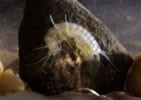 |
Cave Life of Wales |
 |
| |
| HOME |
| INTRODUCTION |
| LIFE IN THE ENTRANCE |
| LIFE IN THE CAVE |
| CONSERVATION |
| GLOSSARY |
| ACKNOWLEDGEMENTS |
| |
| Bacteria |
| Fungi |
| Plants, Algae & Protozoans |
| Sponges |
| Flatworms |
| Eelworms & Segmented Worms |
| Slugs & Snails |
| Crustacea |
| Insects |
| Spiders & Millipedes |
| Fish & Amphibians |
| Birds |
| Bats |
Life in the cave - Flatworms |
Flatworms are simple white or brown flattened worms and move about their damp habitat by a series of undulations. Most flatworms are free-living, many are parasitic, but the larger ones found in caves are predators. Although simple they have a bilateral nervous system and the head end of some species even has a rudimentary brain to integrate signals from eyespots. Some have the ability to continue to grow as two flatworms when cut in half - the bit that had the tail grows a new tail and its tail becomes the head. Those in the caves are small (about 2cm long or less) and leave a slimy mucus trail to trap their prey. Both the white Phagocata vitta and the grey Crenobia alpina (8-12mm) are found in Porth yr Ogof. They are intolerant of summer temperatures and are commonly found in caves and cool mountain streams. They breed both sexually and asexually (by fission) and feed on oligochates, crustacea, and larval chiromnomids; C. alpina also feeds on stonefly and caddisfly nymphs.
|
